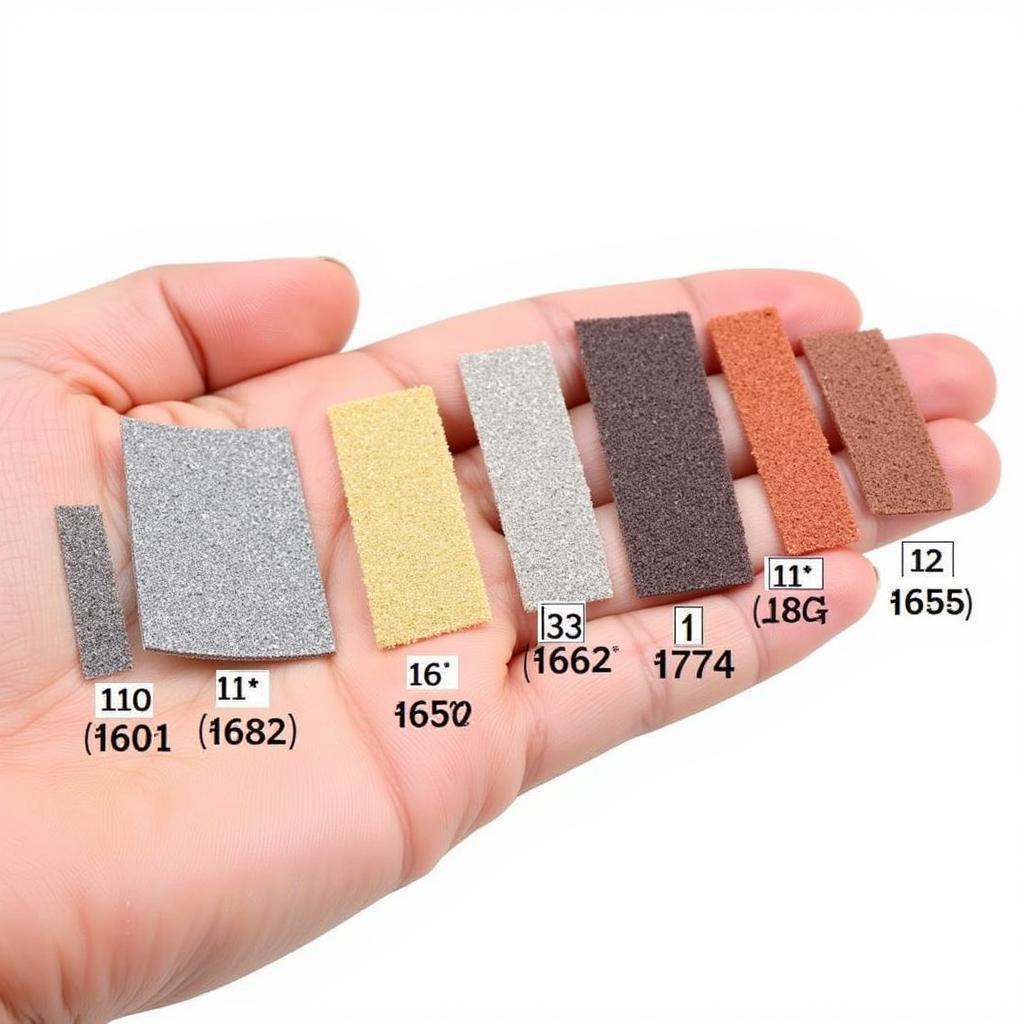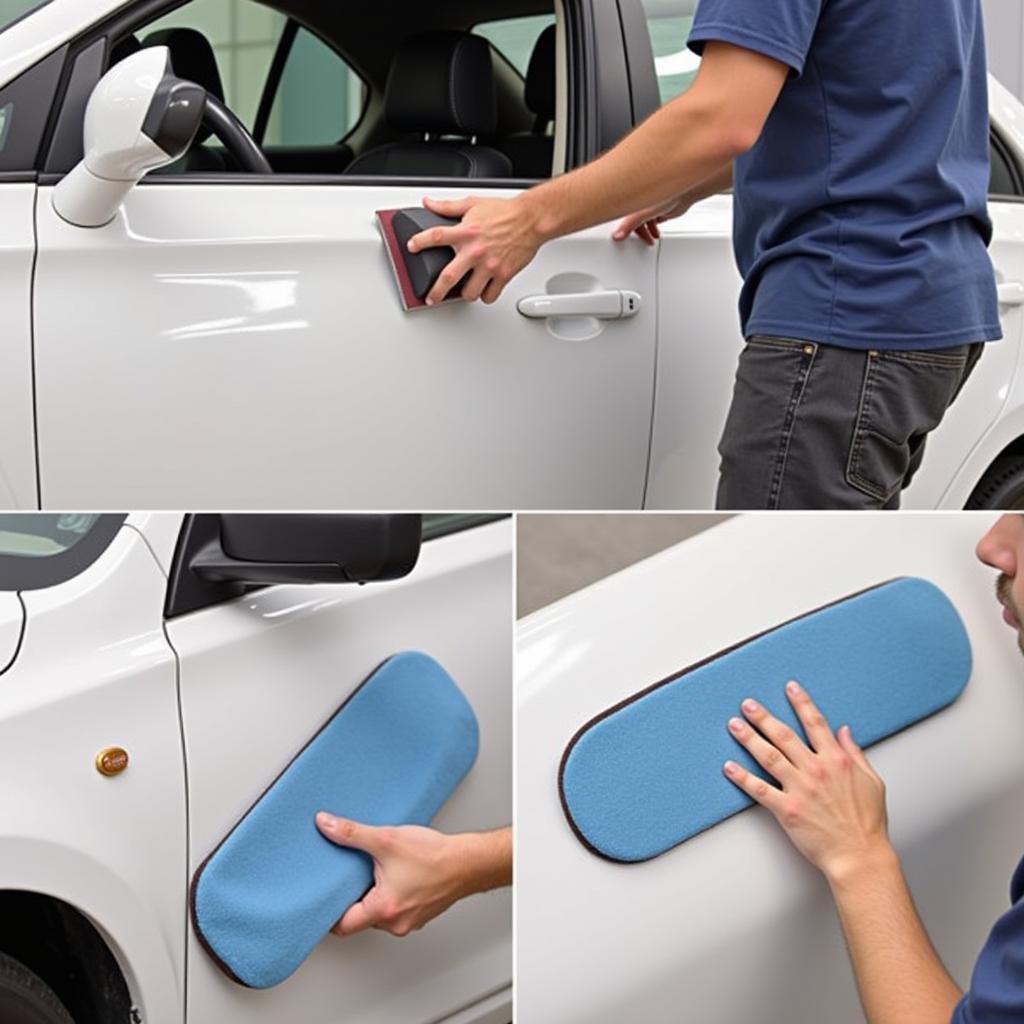Sanding is a crucial step in preparing a car for painting. Using the right Sanding Tools For Painting A Car ensures a smooth, even surface for the paint to adhere to, resulting in a professional-looking finish. Choosing the best sanding tools can seem daunting with so many options available. This guide will cover everything you need to know about sanding tools for painting a car, from different types to proper techniques.
Types of Sanding Tools for Car Painting
Different stages of car painting require different sanding tools. Understanding their specific uses will help you select the right tool for the job.
Hand Sanding Tools
- Sandpaper: Sandpaper comes in various grits, ranging from coarse to very fine. Coarser grits are used for initial sanding and removing imperfections, while finer grits are for smoothing the surface before painting. Remember, a lower grit number indicates a coarser abrasive.
- Sanding Blocks: Using a sanding block provides even pressure distribution, preventing uneven sanding and swirl marks. They are especially helpful for flat surfaces.
- Sanding Sponges: Flexible sanding sponges conform to curved surfaces and are excellent for sanding intricate details. They’re available in various shapes and grits.
Power Sanding Tools
- Orbital Sander: The orbital sander is a versatile tool that moves in small, random orbits, minimizing swirl marks. It’s suitable for various sanding tasks, from removing old paint to smoothing the primer.
- Dual-Action (DA) Sander: The DA sander combines orbital and rotary motions, offering more aggressive sanding than a standard orbital sander. It’s useful for removing heavier imperfections but requires careful handling to avoid damaging the car’s body.
- Belt Sander: Belt sanders are powerful tools for quickly removing material. However, they’re not recommended for beginners due to their aggressive nature. Improper use can easily create deep scratches. Consider tools needed to fix car scratches after using a belt sander incorrectly. You might even need a car paint chip repair tool.
Choosing the Right Sandpaper Grit
Selecting the correct sandpaper grit is essential for achieving a flawless paint job. Starting with a coarser grit and progressively moving to finer grits ensures a smooth, even surface. If you’re restoring an old vehicle, you’ll need a comprehensive list of tools needed to restore an old car at home.
- Coarse Grits (40-80): Used for removing rust, old paint, and major imperfections.
- Medium Grits (100-180): Used for smoothing the surface after initial sanding and feathering edges.
- Fine Grits (220-320): Used for final smoothing before applying primer or paint.
- Ultra-Fine Grits (400-600): Used for wet sanding between coats of paint.
 Comparing Different Sandpaper Grits
Comparing Different Sandpaper Grits
Sanding Techniques for a Professional Finish
Proper sanding techniques are just as important as using the right tools. Following these tips will help you achieve a professional-looking paint job:
- Use a Sanding Block: This ensures even pressure and prevents swirl marks.
- Sand in Straight Lines: Avoid sanding in circular motions, which can create visible scratches.
- Overlap Each Stroke: Overlap each sanding stroke by about 50% to ensure even sanding.
- Clean the Surface Regularly: Remove sanding dust frequently to prevent clogging the sandpaper and scratching the surface.
- Use a Tack Cloth: Before applying primer or paint, wipe down the surface with a tack cloth to remove any remaining dust. If you are in Australia and need tools, look for car body repair tools australia.
 Demonstrating Correct Sanding Technique
Demonstrating Correct Sanding Technique
Conclusion
Sanding is a critical step in the car painting process. Using the right sanding tools for painting a car and proper techniques ensures a smooth, professional finish. By following the information in this guide, you can achieve a flawless paint job that will make your car look its best. Remember, a MATCO tools MT2432 car sander is a valuable tool for this process.
FAQs
-
What is the best grit sandpaper for sanding a car before painting? The best grit depends on the current condition of the car’s surface. Start with coarser grits for removing imperfections and gradually move to finer grits for smoothing.
-
Can I use a power sander for the entire sanding process? While power sanders are helpful, hand sanding is often necessary for intricate areas and final smoothing.
-
How do I prevent swirl marks when sanding? Use a sanding block and sand in straight lines, overlapping each stroke.
-
What should I do after sanding before painting? Thoroughly clean the surface with a tack cloth to remove all dust particles.
-
How often should I replace my sandpaper? Replace sandpaper when it becomes clogged or worn out.
-
Do I need to wear a mask while sanding a car? Yes, always wear a mask and eye protection while sanding to protect yourself from dust and debris.
-
How can I find the best car paint chip repair tool? DiagFixPro has a guide specifically on car paint chip repair tools.
Need help with your car diagnostics? Contact us via WhatsApp: +1(641)206-8880, Email: [email protected] or visit us at 910 Cedar Lane, Chicago, IL 60605, USA. Our customer support team is available 24/7.

Leave a Reply